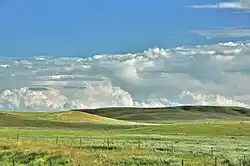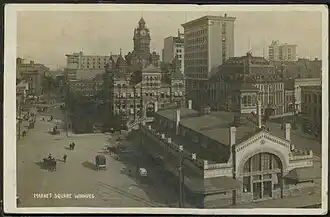
The Dominion Lands Act of Canada was a land act which the government of Canada established in 1872 to try and encourage settlement of the Canadian interior, particularly around Manitoba, Saskatchewan and Alberta, the Canadian Prairies. It was partly issued in response to the Homestead Act which the government of the United States had established in 1862 to encourage settlement of the Great Plains and other parts of the American West, as there were overlapping land claims held by the US and Canada over southern Saskatchewan and Alberta. The Dominion Lands Act offered plots of 160 acres of land to any adult settler who agreed to head out west to the prairies and develop their allotments as farmers. Over the next 58 years, until it was drastically curtailed in 1930, 625,000 patents for lands were issued to settlers and the Dominion Lands Act played an enormous role in the settling of the Canadian Prairies and Western Canada, particularly so in the 1880s, 1890s and 1900s.[1]
Research your ancestors on MyHeritage
Dominions Lands Act chronology of eventsDominions Lands Act chronology of events
Prior to the nineteenth century European settlement of Canada had largely been restricted to the eastern parts of the country around Quebec, Ontario, Newfoundland, Prince Edward Island and other relatively temperate regions on the coast of the Atlantic Ocean. Much of the central and western parts of what is now Canada had barely even been mapped, let alone settled in any manner. The Hudson’s Bay Company was exploring the region in greater depth though as part of its fur-trading business and the British government was laying down its claims to this section of the continent west to the Pacific Ocean against the competing land claims of the United States.[2]
After the British Canadian provinces in the east entered federation in 1867 and acquired growing powers of self-determination from Britain they turned their thoughts to securing the central and western parts of the country. They especially wished to encourage settlement of the Canadian Prairies, a vast, lowland region lying across the southern halves of the modern-day provinces of Manitoba, Saskatchewan and Alberta. There was prime farmland here if settlement of this part of the continent could be encouraged. Thus, in 1872 the government passed the Dominion Lands Act. It was deliberately modeled on the Homestead Act of 1862 which the government of Abraham Lincoln had passed in Washington D.C. to encourage westward settlement of the Great Plains and American West. Through the Canadian act settlers who committed to heading out west and living on the Prairies as farmers would be given 160-acre plots of land for free.[3]
The Dominion Lands Act did not initially have the desired effect. This was owing to a clause which stipulated that settlers could only avail of land for free if the lands lay over 20 miles from a railway. The government hoped to make money from selling the more prime land closer to the railway lines. Settlers were reluctant to take up lands on that basis, as it would require them to transport their grain and other produce over 30 kilometers to a railway depot for the produce to be transported eastwards to the markets in the major cities. Aware that this was limiting uptake of lands, the government revised this provision in 1879 by halving the distance involved to 10 miles or 16 kilometers, while three years later in 1882 the railway clause was dispensed with entirely. As soon as this clause was revised the numbers of individuals availing of free lands and heading out west to the Prairies exploded upwards.[4]
It was not all smooth sailing. The First Nations people of the Prairies had not been consulted about their land being given away to colonial settlers and, just like the Sioux and Lakota Indians further to the south on the Great Plains of America, resisted the encroachment onto their lands. The foremost such revolt was the North-West Rebellion of 1885.[5] Over time the resistance was defeated and in 1905 Saskatchewan and Alberta were created into provinces, a clear sign of how settled the Canadian Prairies were by that time. Lands continued to be dispensed by the Canadian government through the Dominion Lands Act until 1930, at which time the act was revised. It was only finally dispensed with in its entirety in 1950. In the twentieth century the Prairies became known as the breadbasket of Canada.
Extent of migration following the Dominion Lands ActExtent of migration following the Dominion Lands Act

Between 1872 and 1930 approximately 625,000 land grants were issued through the Dominion Lands Act. This means that it was responsible for the migration of well over a million people out to Manitoba, Saskatchewan and Alberta. We can get a sense of this by examining the foundation dates of some of the major cities in these three provinces. Virtually all of them were first settled and incorporated in the two decades after the Lands Act came into being. Calgary (Alberta) was founded in 1875, Brandon in 1879 (Manitoba), Regina in 1882 (Saskatchewan) and Saskatoon in 1883 (Saskatchewan), while other urban centers such as Edmonton (Alberta) and Winnipeg (Manitoba) which predated the Dominion Lands Act had been little more than forts and fur-trading stations prior to the 1870s.[6]
Some of these had turned into substantial cities by 1900 and continued to grow speedily thereafter as more and more people arrived to the Prairies. Winnipeg, for instance, had a population of just 3,700 people in the mid-1870s, but had expanded to 42,000 by 1900 and grew fivefold to 200,000 inhabitants by 1925.[7] Calgary had 4,000 inhabitants in 1884 when it was incorporated as a city. There were 47,000 people there by 1912.[8] Regina had not existed when the Dominion Lands Act was introduced. By 1930 when the terms of the act were revised to end free land grants, Regina was a thriving provincial capital of over 50,000 people.[9]
Demographic impact of the Dominion Lands ActDemographic impact of the Dominion Lands Act
The demographic impact of the Dominion Lands Act was very substantial. It hugely accelerated the westward expansion of Canada and the settlement of the Prairies in particular. Today there are 6.7 million people living in the three provinces of Manitoba, Saskatchewan and Alberta which were most impacted by the land grants. Settlers also came from far and wide, expanding the ethnic composition of Canada as news spread around Europe that free land was being made available in Canada to those willing to head out there and settle on the frontier. Thus, the Prairies were settled by groups arriving from Germany, the Balkans, Scandinavia and the lands of the Russian Empire who did not previously have a tradition of migrating to British Canada prior to federation. In short, the Dominion Lands Act helped to transform Canada. Millions of Canadians today will be able to trace their ancestry back to individuals who headed out to the Prairies between the 1870s and 1920s to avail of free land grants there.[10]
See alsoSee also
Explore more about the Dominion Lands Act of CanadaExplore more about the Dominion Lands Act of Canada
- Canada Directories records collection on MyHeritage
- Canada Newspapers, 1752-2007 records collection on MyHeritage
- 1881 Canada Census records collection on MyHeritage
- 1901 Canada Census records collection on MyHeritage
- 1916 Canada Census of Alberta, Saskatchewan and Manitoba records collection on MyHeritage
- Canada, Saskatchewan Births, 1832-1921 records collection on MyHeritage
- Canada, Manitoba, Birth Index, 1880-1919 records collection on MyHeritage
- Canada Burials, 1800-2019 records collection on MyHeritage
- Family History on the Canadian Prairies at Legacy Family Tree Webinars
- How to Find Marriage, Birth and Death Registrations in Canada at Family Tree Webinars
- Tracing Your Alberta Connections at Legacy Family Tree Webinars
- Finding Your Ancestors in Canadian Land Records at Legacy Family Tree Webinars
References
- ↑ https://www.thecanadianencyclopedia.ca/en/article/dominion-lands-policy
- ↑ https://canadiangeographic.ca/articles/the-untold-story-of-the-hudsons-bay-company/
- ↑ James M. Richtik, ‘The Policy Framework for Settling the Canadian West, 1870–1880’, in Agricultural History, Vol. 49, No. 4 (October, 1975), pp. 613–628.
- ↑ https://www.thecanadianencyclopedia.ca/en/article/dominion-lands-policy
- ↑ https://indigenouspeoplesatlasofcanada.ca/article/1885-northwest-resistance/
- ↑ https://www.thecanadianencyclopedia.ca/en/article/prairie-west
- ↑ https://www.winnipeg.ca/people-culture/winnipegs-history
- ↑ http://www.incalgary.com/History%20of%20Calgary.htm
- ↑ https://www.thecanadianencyclopedia.ca/en/article/regina
- ↑ https://www.thecanadianencyclopedia.ca/en/article/prairie-west

